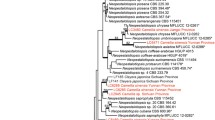Abstract
Paecilomyces lilacinus is a geographically widespread nematophagous fungus and a promising biological control agent against plant parasitic nematodes. However, relatively little is known about its patterns of genetic variation through its broad geographic and ecological contexts. In this study, we analyzed the genetic variation of 2 virulence-associated genes (PLS and PLC) and 4 housekeeping gene fragments (ITS, RPB1, RPB2, and β-tubulin) among 80 P. lilacinus specimens collected from 7 locations in China. Various degrees of polymorphism and haplotype diversity were observed among the six gene fragments. However, no genetic differentiation was observed among the geographic populations, consistent with extensive gene flow among these geographic populations of P. lilacinus in China. Our analysis also suggested that clonal reproduction was the predominant mode of reproduction in natural populations of P. lilacinus.
Similar content being viewed by others
References
Agapow, P. and Burt, A. 2001. Indices of multilocus linkage disequilibrium. Mol. Ecol. Notes1, 101–102.
Bonants, P.J., Fitters, P.F., Thijs, H., den Belder, E., Waalwijk, C., and Henfling, J.W. 1995. A basic serine protease from Paecilomyces lilacinus with biological activity against Meloidogyne hapla eggs. Microbiology141, 775–784.
Burt, A.C., Carter, D.A., Koenig, G.L., White, T.J., and Taylor, J.W. 1996. Molecular markers reveal cryptic sex in the human pathogen Coccidioides immitis. Proc. Natl. Acad. Sci. USA93, 770–773.
Chew, J., Strongman, D., and Mackay, R. 1998. Comparisons of twenty isolates of the entomopathogen Paecilomyces farinosus by analysis of RAPD markers. Mycol. Res.102, 1254–1258.
Dong, L., Yang, J., and Zhang, K. 2007. Cloning and phylogenetic analysis of the chitinase gene from the facultative pathogen Paecilomyces lilacinus. J. Appl. Microbiol.103, 2476–2488.
Fargues, J., Bon, M.C., Manguin, S., and Couteaudier, Y. 2002. Genetic variability among Paecilomyces fumosoroseus isolates from various geographical and host insect origins based on the rDNA-ITS regions. Mycol. Res.106, 1066–1074.
Finlay, B.J. 2002. Global dispersal of free-living microbial eukaryote species. Science296, 1061–1063.
Fournier, A., Widmer, F., and Enkerli, J. 2010. Development of a single nucleotide polymorphism (SNP) assay for genotyping of Pandora neoaphidis. Fungal. Biol-UK.114, 498–506.
Hewlett, T., Dickson, D., Mitchell, D., and Kannwischer-Mitchell, M. 1988. Evaluation of Paecilomyces lilacinus as a biocontrol agent of Meloidogyne javanica on tobacco. J. Nematol.20, 578–584.
Khan, A., Williams, K., Molloy, M., and Nevalainen, H. 2003. Purification and characterization of a serine protease and chitinases from Paecilomyces lilacinus and detection of chitinase activity on 2D gels. Protein Expr. Purif.32, 210–220.
Kiewnick, S. and Sikora, R. 2006. Biological control of the root- knot nematode Meloidogyne incognita by Paecilomyces lilacinus strain 251. Biol. Control.38, 179–187.
Lan, L. and Xu, J. 2006. Multiple gene genealogical analyses suggest divergence and recent clonal dispersal in the opportunistic human pathogen Candida guilliermondii. Microbiology152, 1539–1549.
Li, Y., Hyde, K., Jeewon, R., Cai, L., Vijaykrishna, D., and Zhang, K. 2005. Phylogenetics and evolution of nematode-trapping fungi (Orbiliales) estimated from nuclear and protein coding genes. Mycologia97, 1034–1046.
Librado, P. and Rozas, J. 2009. DnaSP v5: a software for comprehensive analysis of DNA polymorphism data. Bioinformatics25, 1451–1452.
Luangsa-ard, J., Hywel-Jones, N., and Samson, R. 2004. The polyphyletic nature of Paecilomyces sensu lato based on 18S-generated rDNA phylogeny. Mycologia96, 773–780.
Peakall, R. and Smouse, P. 2006. GENALEX 6: genetic analysis in Excel. Population genetic software for teaching and research. Mol. Ecol. Notes6, 288–295.
Prospero, S., Lung-Escarmant, B., and Dutech, C. 2008. Genetic structure of an expanding Armillaria root rot fungus (Armillaria ostoyae) population in a managed pine forest in southwestern France. Mol. Ecol.17, 3366–3378.
Richards, E., Reichardt, M., and Rogers, S. 1994. Preparation of genomic DNA from plant tissue, pp. 2.3.1–2.3.7. In Ausubel, F.M., Brent, R., Kingston, R.E., Moore, D.D., Seidman, J.G., Smith, J.A., and Struhl, K. (eds.), Current protocols in molecular biology-1994. John Wiley & Sons, Inc., New York, N.Y., USA.
Samson, R. 1974. Paecilomyces and some allied hyphomycetes. Stud. Mycol.6, 1–119.
Sha, T., Xu, J., Palanichamy, M., Zhang, H., Li, T., Zhao, Z., and Zhang, Y. 2008. Genetic diversity of the endemic gourmet mushroom Thelephora ganbajun from south-western China. Microbiology154, 3460–3468.
Stolk, A. and Samson, A. 1972. The genus Talaromyces: Studies on Talaromyces and related genera II. Stud. Mycol.2, 1–65.
Swofford, D. 2002. PAUP*: phylogenetic analysis using parsimony (* and other methods). Sinauer Associates Inc, Sunderland, MA, USA.
Thompson, J., Gibson, T., Plewniak, F., Jeanmougin, F., and Higgins, D. 1997. The CLUSTAL_X windows interface: flexible strategies for multiple sequence alignment aided by quality analysis tools. Nucleic Acids Res.25, 4876–4882.
Tigano-Milani, M., Samson, R., Martins, I., and Bruno, W. 1995a. DNA markers for differentiating isolates of Paecilomyces lilacinus. Microbiology141, 239–245.
Tigano-Milani, M.S., Honeycutt, R.J., Lacey, L.A., Assis, R., Mc-Clelland, M., and Sobral, B.W.S. 1995b. Genetic variability of Paecilomyces fumosoroseus isolates revealed by molecular markers. J. Invertebr. Pathol.65, 274–282.
Wang, H., Guo, H., Sun, S., and Xu, J. 2007. Abundant sequence variation around the mitochondrial origin of replication in the human opportunistic yeast pathogen Candida albicans from a tropical island in China. Fungal Genet. Biol.44, 991–1001.
Xu, J. 2004. The prevalence and evolution of sex in microorganisms. Genome47, 775–780.
Xu, J. 2006. Microbial ecology in the age of genomics and metagenomics: concepts, tools, and recent advances. Mol. Ecol.15, 1713–1731.
Zaki, F. and Bhatti, D. 1990. Effect of castor (Ricinus communis) and the biocontrol fungus Paecilomyces lilacinus on Meloidogyne Ja Vanica. Nematologica36, 114–122.
Author information
Authors and Affiliations
Corresponding author
Additional information
These authors contributed equally to this work.
Supplemental material for this article may be found at http://www.springerlink.com/content/120956.
Electronic supplementary material
Rights and permissions
About this article
Cite this article
Li, J., Li, H., Bi, X. et al. Multiple gene genealogical analyses of a nematophagous fungus Paecilomyces lilacinus from China. J Microbiol. 51, 423–429 (2013). https://doi.org/10.1007/s12275-013-2599-6
Received:
Accepted:
Published:
Issue Date:
DOI: https://doi.org/10.1007/s12275-013-2599-6




